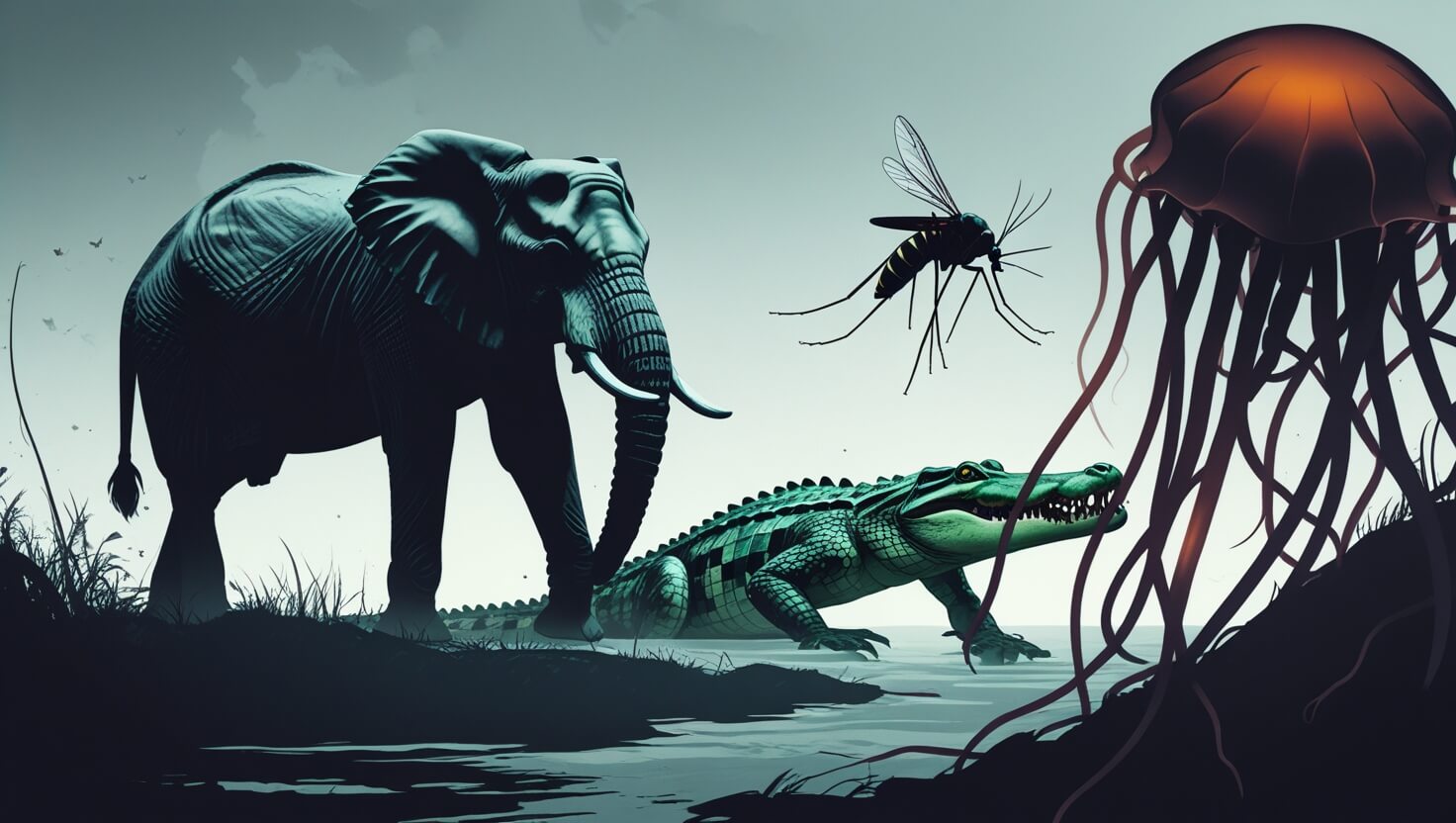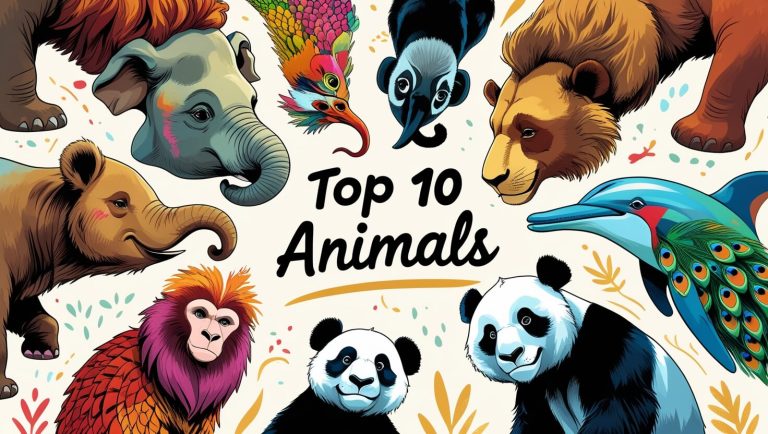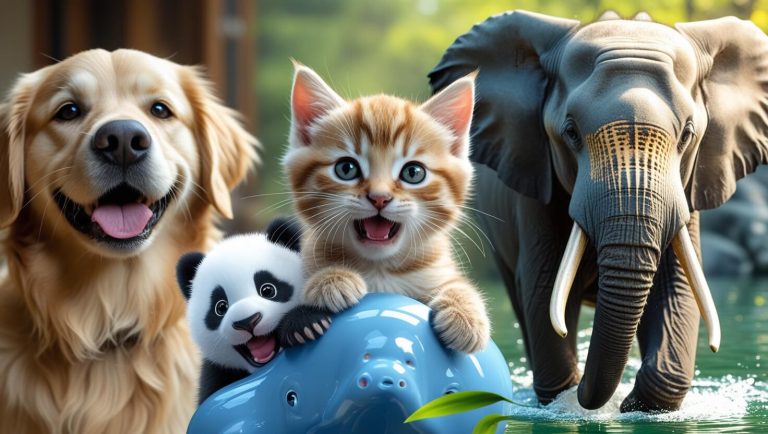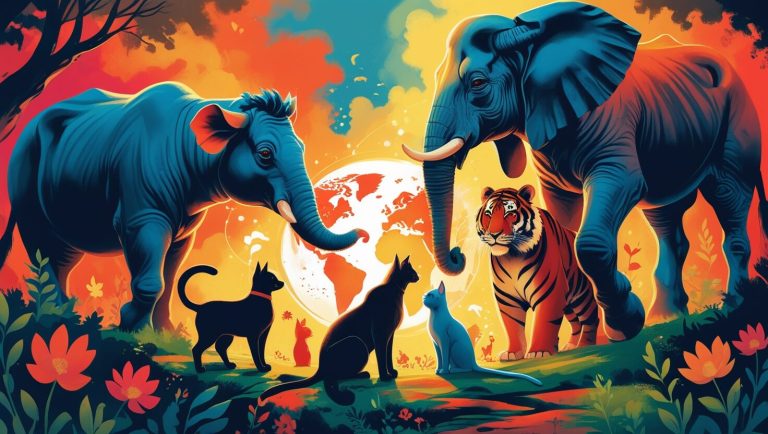Top 10 Most Dangerous Animals : Deadliest Creatures Ranked
Every year, millions of people encounter wild animals—but not all of them walk away.
The natural world is a place of breathtaking beauty and incredible wonder, but it is also a realm of raw power and untamed survival. For all our technological advancements and urban comforts, we remain a part of this ecosystem, and sometimes, our paths cross with creatures for whom we are either a threat, a meal, or simply an unfortunate accident.
Understanding the animals that pose the greatest risk is more than just a morbid curiosity; it’s a matter of safety and respect. By learning about these deadly creatures, we can better appreciate the intricate balances of nature and, most importantly, learn how to coexist safely.
In this comprehensive guide, we will delve into the lives of the world’s most dangerous animals. Our ranking is not based on ferocity or size alone, but on a clear, data-driven methodology that reveals the true killers of the animal kingdom. Get ready to have some of your common assumptions challenged and to discover the creatures that are, by a wide margin, the deadliest threats to human life.
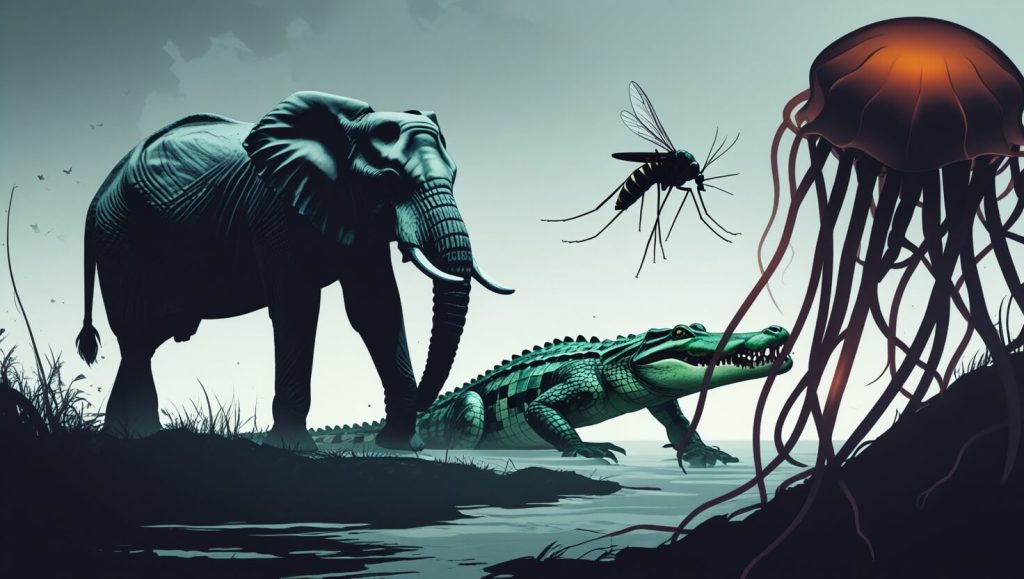
Criteria for Ranking
Before we dive into the list, it’s essential to understand the criteria we used to rank these animals. The term “dangerous” can be subjective, so we’ve defined it using a combination of factors that objectively measure the threat each animal poses to humans.
- Number of Human Deaths Caused: This is the primary and most significant metric. The ultimate measure of an animal’s danger is its track record of causing human fatalities, a statistic that often defies popular perception.
- Lethality: This encompasses an animal’s ability to kill a human, whether through potent venom, immense physical strength, or stealthy, predatory attacks. A single bite from a highly venomous snake, for example, is more lethal than a scratch from a less dangerous animal.
- Geographic Spread and Frequency of Contact: An animal’s danger is magnified if it inhabits areas where it frequently comes into contact with humans. A highly venomous snake in a remote, unpopulated desert poses less of a threat than a venomous spider in a suburban backyard.
- Human Interaction Risk Level: This measures the likelihood of an unprovoked attack. Some animals, like hippos, are notoriously aggressive and territorial, while others, like the inland taipan, are reclusive and attack only when cornered.
Using these criteria, we have compiled a list that is as surprising as it is terrifying. Let’s count them down.
Top 10 Most Dangerous Animals
1. The Mosquito
This tiny insect, often dismissed as a mere nuisance, is, without question, the deadliest animal on the planet. Responsible for an estimated 700,000 to 1 million human deaths annually, the mosquito’s danger lies not in its bite, but in its role as a disease vector.
- Why It’s Dangerous: The mosquito’s ability to transmit a host of deadly pathogens is unrivaled. It carries malaria, which alone accounts for hundreds of thousands of deaths each year, primarily in sub-Saharan Africa. It also transmits dengue fever, West Nile virus, yellow fever, Zika, and a variety of other debilitating and often fatal diseases.
- Where It’s Found: Found in every region of the world except Antarctica, the mosquito thrives in warm, humid climates, especially near standing water.
- Prevention Tips: The most effective defense against the world’s deadliest animal is simple prevention. Using mosquito nets while sleeping, applying insect repellent, wearing long-sleeved clothing, and—most importantly—eliminating any sources of standing water around your home are all crucial steps.
2. The Box Jellyfish
Often considered the ocean’s deadliest inhabitant, the box jellyfish is a creature of terrifying beauty and lethal potency. Its translucent, cube-shaped bell and up to 15 tentacles, each reaching nearly 10 feet in length, are a nightmare for any unsuspecting swimmer.
- Why It’s Dangerous: The box jellyfish possesses a venom so powerful it can cause cardiac arrest, paralysis, and excruciating pain within minutes of a sting. Its venom attacks the heart, nervous system, and skin cells simultaneously. A single tentacle can contain enough venom to kill over 60 people.
- Where It’s Found: The coastal waters of the Indo-Pacific, from northern Australia to the Philippines, are home to the most lethal species.
- Appearance and Stealth: Its translucent body makes it nearly invisible in the water, adding to the risk.
- Treatment: Immediate treatment is critical. If stung, the first-aid response is to pour liberal amounts of vinegar on the sting to neutralize any remaining venom on the skin. Do not rub the area, as this can cause more venom to be released.
3. The Saltwater Crocodile
The saltwater crocodile is a relic from the age of dinosaurs, and its predatory instincts are just as formidable today. As the largest living reptile, it can grow to over 20 feet long and weigh more than a ton, making it an apex predator in its native habitat.
- Why It’s Dangerous: This creature is an ambush predator with a bone-crushing bite and a deadly “death roll,” a technique used to dismember its prey. It is fiercely territorial and will attack anything that enters its domain, including humans.
- Where It’s Found: Primarily in the brackish and saltwater habitats of Southeast Asia, Northern Australia, and Eastern India.
- Historical Attacks: While precise numbers are hard to track, saltwater crocodiles are responsible for hundreds of attacks on humans annually, with a high fatality rate.
4. The African Elephant
The African elephant is a symbol of majesty and power, but it is also a powerful and unpredictable animal responsible for an estimated 500 deaths each year in Africa.
- Why It’s Dangerous: While they are generally peaceful herbivores, elephants are incredibly intelligent and can be highly aggressive, especially when they feel threatened or if their young are at risk. Their sheer size and strength—weighing up to 13,000 pounds—make them capable of crushing a human with a single stomp or sweep of their trunk.
- Behavior: Male elephants can enter a state of heightened aggression known as “musth,” during which they are unpredictable and extremely dangerous.
- How to Avoid Aggression: When encountering an elephant in the wild, the best course of action is to give it a wide berth. Pay attention to their body language; flared ears, a raised head, and trumpeting are all clear signs of a potential charge.
5. The Hippopotamus
Known for their docile, playful appearance, hippos are one of the most misunderstood and dangerous animals in Africa. They are surprisingly fast, both on land and in water, and are responsible for more human deaths in Africa than lions or any other large mammal.
- Why It’s Dangerous: Hippos are extremely territorial and defensive, especially in water. They see humans as a threat and will not hesitate to charge. Their massive jaws, capable of opening 180 degrees, are equipped with tusks that can easily crush a human or capsize a small boat.
- Dangers: The majority of hippo-related deaths occur when people are traveling in boats or canoes, as the hippos will often overturn them and attack the occupants.
6. The Cape Buffalo (African Buffalo)
With its formidable horns and a reputation for being fearless and unpredictable, the Cape Buffalo has earned the chilling nickname “Black Death.”
- Why It’s Dangerous: Unlike other large herbivores that might flee from danger, the Cape buffalo is known for its tendency to charge without provocation. It is also an intelligent animal that can circle back and ambush a pursuer, making it a particularly dangerous quarry for hunters.
- Where It’s Found: The plains and forests of Sub-Saharan Africa.
7. The Cone Snail
The cone snail is a small but deadly marine predator that hides its lethality behind a beautiful, conical shell.
- Why It’s Dangerous: This snail preys on small fish by firing a venomous, harpoon-like tooth that can deliver a potent neurotoxin. The venom causes paralysis and can be fatal to humans in minutes. To make matters worse, there is no known antivenom, making a sting a dire medical emergency.
- Where It’s Found: Primarily in the warm waters of the Indo-Pacific.
8. The Golden Poison Dart Frog
This small, vibrantly colored frog is a living jewel of the rainforest, but its brilliant hue is a potent warning: it is the most poisonous vertebrate on Earth.
- Why It’s Dangerous: The frog’s skin is coated in a powerful alkaloid toxin called batrachotoxin. A single golden poison dart frog contains enough toxin to kill ten adult men. The poison can be absorbed through the skin, making any contact potentially fatal.
- Indigenous Use: Indigenous tribes of Colombia have historically used the frog’s toxin to coat the tips of their hunting darts, hence the name.
- Where It’s Found: The rainforests of Colombia.
9. The Inland Taipan (Fierce Snake)
Hailing from the remote, arid regions of Australia, the Inland Taipan holds the title of the world’s most venomous snake.
- Why It’s Dangerous: Its venom is a powerful neurotoxin that can paralyze a person’s muscles and cause respiratory failure within hours. A single bite contains enough venom to kill 100 people.
- Why It’s Rarely Dangerous: Despite its potency, the Inland Taipan is an extremely reclusive and shy snake. It lives in sparsely populated areas and will almost always flee from human contact. Most bites have occurred when people have actively handled the snake.
10. Humans
Rounding out the list is a sobering reflection on ourselves. When it comes to sheer destructive power and a capacity for killing, no other species on Earth comes close.
- The Ultimate Apex Predator: Through warfare, violence, and reckless disregard for life, we are responsible for the death of millions of our own kind.
- Impact: Our actions have led to the extinction and endangerment of countless other species, driven by habitat destruction, pollution, and the climate crisis. We are the most dangerous animal on Earth, not just to each other, but to every living thing we share the planet with.
Honorable Mentions
While they didn’t make our top 10, these animals still pose a significant threat and deserve a mention.
- Pufferfish (Fugu): Found in oceans worldwide, this fish contains a deadly neurotoxin called tetrodotoxin, especially in its organs. While it is not aggressive, its consumption by humans, particularly as the delicacy fugu, can be fatal if prepared incorrectly.
- King Cobra: The world’s longest venomous snake, the king cobra can deliver a massive amount of venom in a single bite. Its size and defensive posture make it a formidable and respected predator.
- Komodo Dragon: The largest lizard on Earth, the Komodo dragon has a venomous bite and a predatory instinct. While slow, it is a powerful ambush predator.
- Brazilian Wandering Spider: This highly aggressive spider has a venomous bite that can cause severe pain and other complications.
Common Myths vs. Real Threats
The popular media often sensationalizes certain animals while ignoring the real threats. Let’s set the record straight.
- Sharks vs. Mosquitoes: A classic example of media misrepresentation. The average shark attack results in fewer than a dozen deaths annually worldwide. Meanwhile, mosquitoes, through the diseases they carry, kill millions. A person is thousands of times more likely to die from a mosquito bite than from a shark attack.
- Are Lions Really Man-Eaters? Lions are powerful predators, but they are not the top killer in Africa. As we’ve seen, hippos and elephants claim far more human lives. A lion’s primary prey is typically large herbivores, and they usually only attack humans when food is scarce or they are old and unable to hunt their natural prey.
Safety Tips in the Wild
Knowledge is your best tool for staying safe. Here is some general advice for interacting with wildlife.
- General Advice: When in a new environment, always respect the local wildlife. Never approach an animal, no matter how small or harmless it seems. Avoid walking in tall grass or brush, where venomous snakes and spiders may be hiding.
- On Safaris or Jungle Treks: Always follow the advice of your guide. Stay in your vehicle during safaris, and never leave food or garbage where it can attract animals.
- First-Aid: Carry a basic first-aid kit that includes supplies for treating bites and stings. Know the emergency numbers for the area you are in.
FAQ Section of Top 10 Most Dangerous Animals
u003cstrongu003eI noticed sharks aren’t on the list. Are they not that dangerous?u003c/strongu003e
Surprisingly, shark attacks are extremely rare. On average, sharks are responsible for only about 5-10 human deaths per year worldwide. You are far more likely to be killed by a falling coconut or a lightning strike than by a shark. Movies have given sharks a fearsome reputation, but in reality, they do not actively seek out humans as prey. Most attacks are cases of mistaken identity.
u003cstrongu003eWhat about snakes? I thought they were one of the biggest killers.u003c/strongu003e
Snakes are incredibly dangerous and were a very close contender for the top of the list. It’s estimated that snakes cause between u003cstrongu003e81,000 and 138,000 deaths per yearu003c/strongu003e. This would easily place them in the top three, if not number two. The main reason they are sometimes ranked separately is that data can be less precise due to underreporting in rural areas. Their venom is undoubtedly one of the most potent u003cstrongu003enatural toxinsu003c/strongu003e on the planet.
u003cstrongu003eWhy are so many of the top animals insects?u003c/strongu003e
Insects like mosquitoes, flies, and bugs are so dangerous because of their scale and efficiency. They exist in trillions, reproduce quickly, and live in close contact with humans. Their primary danger isn’t their bite itself, but their ability to act as u003cstrongu003edisease vectorsu003c/strongu003e, transferring pathogens from one person to another with incredible speed across entire populations.
u003cstrongu003e What is the most venomous animal in the world?u003c/strongu003e
This is a different question from u0022most dangerous.u0022 The title of most venomous animal often goes to the u003cstrongu003eInland Taipanu003c/strongu003e snake, whose venom is incredibly potent. However, it lives in remote parts of Australia and is very shy, so it rarely encounters humans. Another contender is the u003cstrongu003eBox Jellyfishu003c/strongu003e, which has venom that can shut down the heart and nervous system very quickly.
u003cstrongu003eHow can I stay safe from these animals if I travel?u003c/strongu003e
Great question! For most travelers, the risk is very low, but it’s always good to be prepared. Use insect repellent, sleep under a mosquito net, and consider anti-malarial medication if traveling to a high-risk area. Always go on safaris with a trained guide. Keep a safe distance from wildlife and never get between an animal and its water source or babies. Shake out your shoes and clothing before putting them on, especially in dry, warm climates.
u003cstrongu003eWhat’s the biggest takeaway from this list?u003c/strongu003e
The biggest takeaway is that the animals we often fear the most (sharks, lions) are not the ones that pose the greatest statistical threat to humans. The real danger comes from much smaller creatures that spread disease. This list teaches us to respect all wildlife, understand the real risks, and appreciate the importance of global health initiatives like vaccination programs and mosquito control. It also reminds us that we have a profound responsibility to manage u003cstrongu003ehuman-wildlife conflictu003c/strongu003e and, most importantly, our own capacity for violence
Conclusion
Our journey through the list of the world’s most dangerous animals reveals a crucial lesson: the greatest dangers often lie in the smallest places. While the image of a shark or a lion may evoke fear, it is the humble mosquito that poses the most significant threat to human life.
The animals on this list are not “evil.” They are simply wild, acting on instinct and doing what they must to survive. The danger they pose to us is often a result of our encroachment on their habitats or our misunderstanding of their behavior.
By respecting nature, understanding the real threats, and taking simple preventative measures, we can ensure our safety and help preserve the delicate balance of the natural world.
Have you had a close encounter with a wild animal? Share your story in the comments below! And don’t forget to subscribe for more fascinating content about wildlife, nature, and survival.
judi bola

Rony Junior is a lifelong animal lover who’s happiest with muddy paws on the couch and fur on their clothes. From curious cats to loyal dogs and everything in between, they write about the joy, challenges, and quirks of living alongside animals. When not blogging, you can find them at the local shelter, giving belly rubs and making new four-legged friends.

